Jetting 101
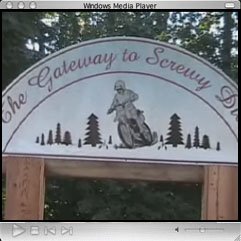 Man did I feel old this week! In the early days of BBR we used to have AC/DC Friday out in the shop. We would fill the disc player up and blow the windows out. We haven’t done it for years, so when I heard they were coming out with a new CD I figured we would relive the “good old days at BBR”. I had to go to Wal-Mart and stand in line with all the other old guys. If that wasn’t enough, by the time I got to work my ears were bleeding! It was too loud so I must be too old. I am officially “that guy” I have been making fun of for the last twenty years! Oh well, at least I never owned a mini van!
Man did I feel old this week! In the early days of BBR we used to have AC/DC Friday out in the shop. We would fill the disc player up and blow the windows out. We haven’t done it for years, so when I heard they were coming out with a new CD I figured we would relive the “good old days at BBR”. I had to go to Wal-Mart and stand in line with all the other old guys. If that wasn’t enough, by the time I got to work my ears were bleeding! It was too loud so I must be too old. I am officially “that guy” I have been making fun of for the last twenty years! Oh well, at least I never owned a mini van!
Have you ever wired a kill button backwards? I assumed that I must have at least once in my life - but apparently not. I was putting a Tokyo-Mods ignition on a fifty the other day when I made the shocking mistake. I fired the bike up and it was purring like a kitten until I touched the levers and grounded out! Now I have been shocked good a few times over the years by things like car ignitions and welders - but never anything like this. I could feel the electricity go up my arms, up my neck, and out my ears! I’ll tell you what; I was wide awake after that. I can also tell you that it won’t happen twice! Of course, everybody in the shop thought it was hysterical.
O.K. lets get to it. This week’s subject is jetting. We get a dozen calls (and e-mails) everyday from people trying to get the jetting right on their bike. I must start by saying that there is no one magic jetting spec for every engine and carb. Every single rider on our race team runs different jetting specs to fit their riding style, even if the motors are the same. Some riders hold it wide open all the time so they don’t care what the power is doing towards the middle or bottom, they just need maximum flow on the top-end. Other guys short shift the bike and never rev it out so they don’t care what the power is doing when the throttle is wide open. Then there are the kids - they usually need the bike to idle and they tend to snap the throttle wide open instantly so they need a different jetting spec. In addition, jetting is also drastically affected by weather, temperature, elevation, octane rating, compression, pipe diameter, exhaust back-pressure, air filter flow, points gap, electronic curve on the CDI box, cam profile, etc. It’s endless. Don’t get frustrated. Anybody with a little patience can get their bike jetted correctly for their own riding style and location.
First, make certain that everything is working as it is meant to. Use a new spark plug, make sure the carb jets are not clogged (can you see light through them?), and use good, fresh gas. On an old bike you need to make sure the needle, the nozzle, and the slide aren’t simply worn out. We’ve seen some XR80s where the carb was actually worn out from use. You’ll never get the bike to run if these simple things aren’t right to start with.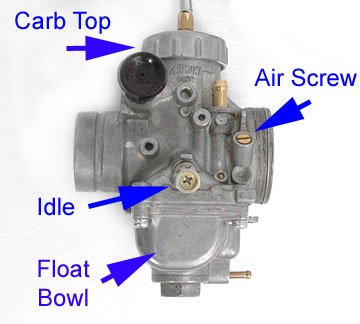 We know that many of our customers understand jetting very well, but since it is a tricky subject for many people, let’s take a minute to go over the basics of the carb, and what each adjustment does to see if we can make this easier to understand. There are three main circuits in the carb that are used for tuning: (1.) the pilot/slow jet, (2.) the needle and clip, and (3.) the main jet. The pilot jet/slow jet affects the very bottom end of the power curve or up to the ¼ throttle open setting. This jet is located under the float-bowl and is the small jet that sits right next to the main jet in the center of most carbs. The pilot/slow jet has a number stamped on the side (usually in the 15-50 range depending on carb size and brand). If the bike is slow to warm up or stumbles right off idle when you snap the throttle, the pilot/slow jet is probably too small (lean - not enough gas). If the bike burbles and chugs like the choke is on right off of idle, then the pilot/slow jet is probably too big (rich – too much gas).
We know that many of our customers understand jetting very well, but since it is a tricky subject for many people, let’s take a minute to go over the basics of the carb, and what each adjustment does to see if we can make this easier to understand. There are three main circuits in the carb that are used for tuning: (1.) the pilot/slow jet, (2.) the needle and clip, and (3.) the main jet. The pilot jet/slow jet affects the very bottom end of the power curve or up to the ¼ throttle open setting. This jet is located under the float-bowl and is the small jet that sits right next to the main jet in the center of most carbs. The pilot/slow jet has a number stamped on the side (usually in the 15-50 range depending on carb size and brand). If the bike is slow to warm up or stumbles right off idle when you snap the throttle, the pilot/slow jet is probably too small (lean - not enough gas). If the bike burbles and chugs like the choke is on right off of idle, then the pilot/slow jet is probably too big (rich – too much gas). 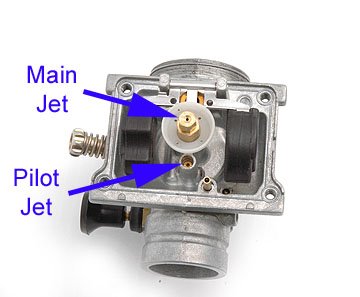 The next adjustment in the carb is the needle and clip. The needle height adjustment affects the midrange part of the power curve, or the half-open throttle setting. The needle is located on the slide. To get to the needle- just unscrew the carb top (where the throttle cable goes in) and pull it out. You will see the slide and needle. To get to the needle just pull the slide spring back and disconnect the cable from the slide.
The next adjustment in the carb is the needle and clip. The needle height adjustment affects the midrange part of the power curve, or the half-open throttle setting. The needle is located on the slide. To get to the needle- just unscrew the carb top (where the throttle cable goes in) and pull it out. You will see the slide and needle. To get to the needle just pull the slide spring back and disconnect the cable from the slide.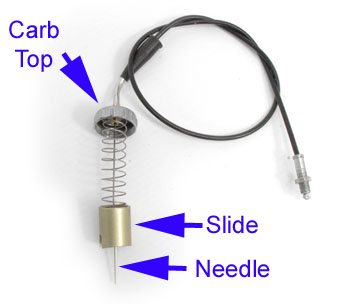
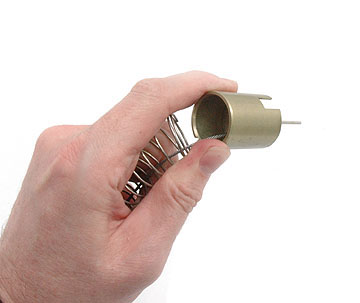
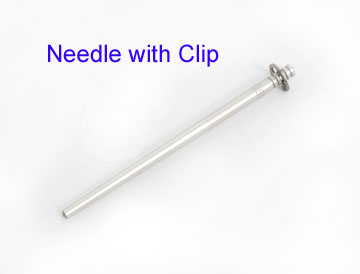
On most slides there is a retaining clip spring that holds the needle and clip down in the slide. Simply pop it out and the needle will slide out. Once the needle is in hand you will see there is a clip (on most carbs) that is snapped into a grove at the top of the needle. By raising the clip, you are lowering the needle, letting less gas down thru the main jet (making the engine run leaner). If you lower the clip you are raising the needle, and letting more gas run throught the main jet (causing the engine to run richer). The needle overlaps both the pilot/slow jet and the main jet, so it gets a little tricky when it comes to adjustment. Usually, I will richen the needle (lower the clip) when installing an aftermarket exhaust, or if the weather is cold out, to send more gas to the engine. If I am installing a quiet pipe, quiet core, or the weather is hot, I will lean (raise the clip) to send less gas to the engine. On some of the new little 4-strokes there is no adjustment on the needle (environmental wackos gone mad). In that case, you will have to order an older needle, cut your own grooves, or stack washers under the needle to adjust it. I sure hope you don’t kill some spotted bug in doing so. If you really want to go crazy, you can also buy different needle sizes that affect midrange jetting. The fatter the needle, the leaner it will run. The thinner the needle, the richer it will run. If you compare different needles you will see varying tapers and diameters. Experimentation is the key to getting this needle setting correct.
The third adjustment is the main jet. The main jet primarily affects ¾ to wide open throttle settings, and is located under the float bowl right in the middle. On some carbs, there is a nut under the float bowl you can remove to get to the main jet without removing the carb from the bike. The main jet will have a number stamped on it, usually from about 90 to 200 depending on carb and application. To be accurate, the main jet really overlaps the pilot/slow jet and the needle affecting the whole circuit. If the bike will not rev out cleanly all the way up to higher rpm’s, then 99% of the time the main jet is too rich – yes too rich! If the main jet is too lean, the bike will rev out cleanly but have a big cough off of idle because the whole jetting circuit is too lean. Start with the biggest main that will let the bike rev all the way out, and then work your way backwards.
O.K. we have covered how to swap the jets. Let’s talk about how to adjust the fuel mixture screw. Most of the time, the stock setting works fine. Depending on the carb, most are set at -¼ to 2 turns out counter clockwise. People act like this is some major carb adjustment, but on these small 4-strokes it doesn’t do much. To get it adjusted properly, just fire the bike up and turn it out until you get the highest idle possible, then go back 1/8-turn and call it good. Basically, this screw adds air to the pilot jet. If you have to go more than 2-turns, you probably have the wrong size pilot jet.
Let’s go over a few more basic jetting tips now that you know how to make the basic adjustments. Race gas and high octane gas effect jetting as much as anything. 4-strokes do not generally like high octane gas. Think of it this way - the higher the octane number, the slower the gas burns. The smaller the octane number, the hotter it burns. You want the smallest octane number possible without allowing the engine to ping or rattle. If you take a stock KLX 110 that runs fine on 92 octane and switch to 112 high octane race gas, it is going to go slower because the gas is burning slower. Now if you do have a high compression motor that runs hot, you will need to run race gas to cool it off. On a typical engine that runs fine on 92 octane, you will need to drop about ten sizes on the main jet when switching to 100 plus octane or it will feel like you are riding with the choke on. A quick way you can tell if you are too rich or too lean is to pull the choke lever on half way while riding. If the bike runs better, you are too lean and need to go richer/bigger on the jets. If it runs worse, then go leaner/smaller. This is a good test for the bottom to mid-range jetting.
Jetting with a new pipe: If you are going to switch to a bigger pipe, it is always a good idea to switch to a larger filter or the bike will tend to be extremely hard to jet. A good example would be a bike like the TT-R125 which has a tiny stock air filter and pipe. If you just switch the pipe it will only be flowing more air and gas at the back side of the engine flow. If you swap to a bigger filter, you can increase the jet sizes and flow more air, fuel, and exhaust to get the power gains you are after.
Jetting for cold or hot weather: If you are going from 65 degree weather to 100 degree weather (like we do when we go to Vegas every year) you can expect to lower or lean out your main jet 10 sizes. Similarly, if you go from 80 degrees in the summer down to 30 degrees in the winter, you are going to have to go bigger on at least the main jet - probably ten sizes or more (just to give you an idea).
Hope this helps with your jetting questions. Please remember, these are only the basics of carb jetting as I see it. Advanced jetting can involve changing nozzles, slide cutaways, carb bore diameters, etc. But don’t be afraid to jump in and give it a shot. Once you ride a perfectly jetted bike, there is no going back. And until fuel injection arrives for all bikes, getting to know jetting is well worth the effort. To make things easier we've put together a Jetting Chart that contains many of the common combinations of bikes and performance parts. It can be found in our Tech/FAQ section along with a 1998 Dirt Bike magazine article on jetting.
http://www.mikuni.com/pdf/vmmanual.pdf
In addition, we have a streaming video that shows an example of how to install and jet an 18mm carb kit you can see here:
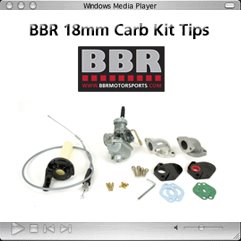
Question of the Week
Can I fit a YZ80 flatslide carb on my XR100. Andy
Anything can be done – look at all of the crazy stuff we have mixed together over the years! But we haven’t had much luck putting two stroke carbs on 4-strokes (especially flat slide models). Every part inside them, from air flow to needle taper, is designed around the two stroke. It is best to purchase an aftermarket carb that is tested to fit the bike you are working on. BBR, of course, has many options. If you are looking for an inexpensive option, you may want to start by finding a carb off a 4-stroke the next model size up from the bike you are working on. That will give you a larger starting point for a carb, and will provide for more top end flow. Hope this helps – Duane
Blast from the Past
This week’s blast from the past comes from the November 1998 issue of Four Stroke Dirt Bikes. Mark Karia made a few issues of the magazine in between freelancing for Dirt Rider and Cycle News in the 90s. Mark flew up and spent a couple of days with us when we were working out of our parent’s backyard shop. Those were some fun times. We had a dozen bikes, three acres, and rode around the clock in those days (I guess we still do). Can’t believe the neighbors still talk to our parents. Looking back, we realize why all of my parent’s neighbors were so willing to help us move out to our new shop.
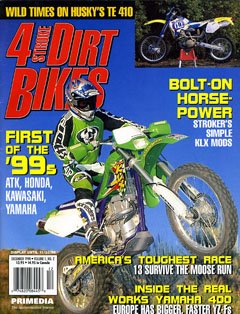 The second article is from Motocross Journal, August 2000 (BBR perimeter framed TT-R 125). There is actually a funny story about this photo shoot……We loaded up the BBR trailer and headed to California for the White Bros Four Stroke World Championships. The day before the race, the guys at Hi-Torque Publishing (MXA, Dirt Bike, Motocross Journal) wanted us to swing by. We were working with Suzuki on a DRZ400 and Hi-Torque wanted photos of our prototype bike before it got hammered at the race. When we arrived, we gave the DRZ one last check over before the photo shoot. I noticed we had forgotten to put the Maxxis stickers on the tires (you know, the bright orange ones you see on all the tires on the factory bikes). At that time we were in deep with Maxxis so we wanted to make sure they were taken care of, and we were proudly displaying the new Maxxis tires on the DRZ prototype. I yelled to one of our guys to get the tire decals on the DRZ in a hurry before the shoot, and then I went with Jody and the MXA guys to the photo studio. When we got back, Jimmy Mac from Motocross Journal said he also took some shots of our TT-R for a future issue. I said awesome!, and we loaded the bikes up and took off for the race. When the magazine showed up three months later, our TT-R125 Race Bike was the main feature, and was spread across the centerfold in all its glory – There was only one little problem…..Dunlop tires with Maxxis stickers! At the time Maxxis didn’t make 16”-19” big wheel sized tires so we had to run the Dunlops on the TT-R’s. One of our race team guys apparently didn’t know this and thought he was doing us all a favor by putting the Maxxis tire decals on ALL of our bikes. Maybe nobody would notice? Needless to say, our phone rang off the hook,.. Motocross Journal’s phone rang,.. Dunlop’s phone rang,..and Maxxis’ phone rang! Nobody thought it was quite as funny as we did. Thank goodness there were no internet forums at the time. It would have been a full-on conspiracy! Anyway, it’s a great article, and our good friend, Rich Taylor, went on to win the 150cc world championships on the TT-R the day after this picture was taken. Enjoy!
The second article is from Motocross Journal, August 2000 (BBR perimeter framed TT-R 125). There is actually a funny story about this photo shoot……We loaded up the BBR trailer and headed to California for the White Bros Four Stroke World Championships. The day before the race, the guys at Hi-Torque Publishing (MXA, Dirt Bike, Motocross Journal) wanted us to swing by. We were working with Suzuki on a DRZ400 and Hi-Torque wanted photos of our prototype bike before it got hammered at the race. When we arrived, we gave the DRZ one last check over before the photo shoot. I noticed we had forgotten to put the Maxxis stickers on the tires (you know, the bright orange ones you see on all the tires on the factory bikes). At that time we were in deep with Maxxis so we wanted to make sure they were taken care of, and we were proudly displaying the new Maxxis tires on the DRZ prototype. I yelled to one of our guys to get the tire decals on the DRZ in a hurry before the shoot, and then I went with Jody and the MXA guys to the photo studio. When we got back, Jimmy Mac from Motocross Journal said he also took some shots of our TT-R for a future issue. I said awesome!, and we loaded the bikes up and took off for the race. When the magazine showed up three months later, our TT-R125 Race Bike was the main feature, and was spread across the centerfold in all its glory – There was only one little problem…..Dunlop tires with Maxxis stickers! At the time Maxxis didn’t make 16”-19” big wheel sized tires so we had to run the Dunlops on the TT-R’s. One of our race team guys apparently didn’t know this and thought he was doing us all a favor by putting the Maxxis tire decals on ALL of our bikes. Maybe nobody would notice? Needless to say, our phone rang off the hook,.. Motocross Journal’s phone rang,.. Dunlop’s phone rang,..and Maxxis’ phone rang! Nobody thought it was quite as funny as we did. Thank goodness there were no internet forums at the time. It would have been a full-on conspiracy! Anyway, it’s a great article, and our good friend, Rich Taylor, went on to win the 150cc world championships on the TT-R the day after this picture was taken. Enjoy!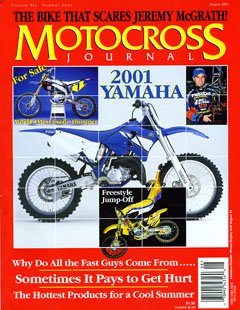 O.K., that’s it for this week. Thanks for all the great feedback and stories about the XR75 blog. Sounds like the whole world was riding them! Thanks for helping us live the dream!
O.K., that’s it for this week. Thanks for all the great feedback and stories about the XR75 blog. Sounds like the whole world was riding them! Thanks for helping us live the dream!Duane
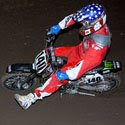

<< Home